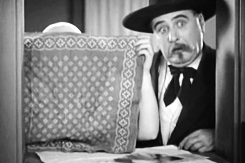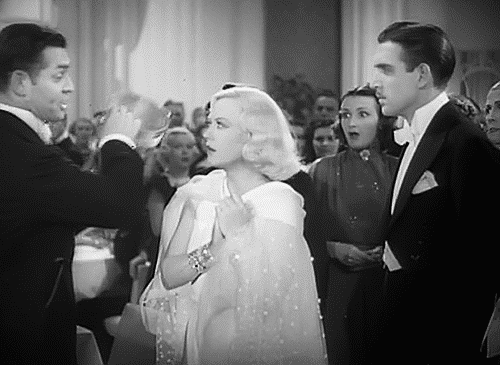Beyond Rosebud: discovering Marion Davies
É sabido que “Cidadão Kane” (1941) foi inspirado
na vida do magnata das comunicações William Randolph Hearst. Em certo ponto do
filme, Kane toma como amante a cantora sem talento Susan Alexander (Dorothy
Comingore), e decide fazer dela uma estrela. Para a posteridade, ficou a
impressão de que foi isso que Hearst fez com sua amante, a atriz Marion Davies
(cujo órgão sexual era chamado por Hearst exatamente de Rosebud, segundo
boatos). Marion era, entretanto, uma talentosa comediante que teve, sim, sua
carreira auxiliada por Hearst, mas que com certeza teria sucesso também sem
ele.
It’s widely known that “Citizen Kane” (1941) was
inspired in William Randolph Hearst’s, the mogul of comunications, life. At a
certain point of the film, Kane takes untalented singer Susan Alexander
(Dorothy Comingore) as his lover and decides to turn her into a star. That’s
why so many people think Hearst did the same with his lover, actress Marion
Davies (whose sexual parts were called exactly Rosebud by Hearst, according to
gossips). Marion was, however, a talented comedienne who indeed had her career
molded by Hearst, but there is no doubt that she would have succeeded even
without him.
Marion Cecelia Douras nasceu no Brooklyn e seguiu
os passos da irmã mais velha, tornando-se dançarina na adolescência. Logo ela
se tornou uma Ziegfeld Girl, e o cinema era seu próximo passo. O filme de
estreia, “Runaway, Romany” (1917) foi também escrito por Marion. Apesar de não
ter feito muito sucesso com esta primeira empreitada, ela continuou atuando, e
“Cecilia of the Pink Roses” (1918) foi o filme que chamou a atenção de Hearst.
Marion Cecelia Douras was born in Brooklyn and
followed her older sister’s footsteps, becoming a dancer as a teenager. Soon
she became a Ziegfeld Girl, and the movies were her next natural step. Her
debut movie, “Runaway, Romany” (1917) was also written by her. This wasn’t a
big hit, but Marion kept on acting, and it was the film “Cecilia of the Pink Roses”
(1918) the one who called Hearst’s attention.
Como qualquer magnata apaixonado, Hearst decidiu
construir um estúdio de cinema só para Marion. A Cosmopolitan Productions
surgiu em 1918, teve seu auge nos anos 20 e se diversificou nos anos 30, quando
até John Ford trabalhou lá. Até 1923 a sede dos estúdios era em Nova York e os
sócios de Hearst no empreendimento eram os estúdios Paramount. Entre 1924 e
1934 Hearst se associou à MGM para distribuir os filmes da Cosmopolitan
Productions, e a partir de 1934 o novo distribuidor foi a Warner Brothers.
Like any mogul in love would do, Hearst decided to
build a movie Studio for Marion. Cosmopolitan Productions was created in 1918,
had its heyday in the 1920s and became a more diverse studio in the 1930s, when
even John Ford worked there. Until 1923 the headquarters were in New York and
the movies were distributed in Hollywood by Paramount. Between 1924 and 1934
MGM was the distributor of the Cosmopolitan Productions, and from 1934 onwards
the distributor was Warner Brothers.
E foi na Cosmopolitan que Marion se aventurou no
drama épico pela primeira vez. Seu grande sucesso no gênero veio com “When
Knighthood was in Flower” (1922), em que ela interpreta a princesa Mary Tudor,
apaixonada por um simples soldado mas atormentada pela sede de poder do irmão,
o rei Henrique VIII (Lyn Harding), que insiste em casá-la com o esquelético rei
da França. As expressões de Marion em alguns close-ups são preciosas, e
a pompa da produção impressiona: são grandes cenários, vistosos figurinos,
milhares de extras e uma bela luta de espadas.
And it was at Cosmopolitan that Marion worked in an
epic drama for the first time. Her big hit in this genre came with “When
Knighthood was in Flower” (1922). In this film she plays Princess Mary Tudor,
who is in love with a simple soldier. She is bothered by her brother’s, King
Henry VII’s (Lyn Harding), obsession with power: he insists in marrying her to
the skinny king of France. Marion’s expressions in some close-ups are precious,
and the fancy production is impressive: there are huge sets, big dresses,
thousands of extras and an exciting sword fight.
Sem dúvida, o melhor filme de Marion Davies, o
primeiro que eu vi com ela e aquele que todos deveriam ver é “Fazendo Fita /
Show People” (1928). Nele, Marion interpreta a singela Peggy Pepper, uma moça
do interior que vai para Hollywood para se transformar em uma grande atriz
dramática. O único emprego que ela consegue, por intermédio de Billy Boone
(William Haines) é em uma comédia slapstick
ao melhor estilo Keystone Cops. Billy
diz que é necessário levar alguns reveses na comédia antes de ter sua grande
chance no drama. Não demora para que Peggy seja notada por um grande estúdio,
mas quando realiza seu sonho (justamente em um épico ao estilo dos que trouxeram
elogios a Marion Davies), ela esquece seus amigos dos velhos tempos da comédia.
Without a doubt, Marion’s best film, the first I’ve
seen her in and the one that everybody must see is “Show People” (1928). Marion
plays Peggy Pepper, a girl who goes to Hollywood to become a successful drama
actress. The only job she gets, thanks to Billy Brone (William Haines), is in a
slapstick comedy, very similar to the Keystone Kops. Billy says it is necessary
to take some pies in the face in comedy movies in order to have a chance at
doing drama. It’s not long until Peggy calls the attention of a big studio, but
when she fulfills her dream (in an epic movie like the ones that brought fame
to Marion Davies), she forgets her old friends from comedy.
Gosto de pensar que a Marion Davies da vida real
se assemelhava muito com sua personagem em “Show People”: determinada, vivaz,
ótima no drama mas absolutamente fantástica na comédia (todo mundo precisa ver
as imitações que Marion faz de outras atrizes do cinema mudo em “Filhinha
Querida / The Patsy”, de 1928). Tanto é que foi a esta que ela dedicou sua
breve carreira no cinema falado.
I like to think that, in real life, Marion Davies was
a lot like her character from “Show People”: bold, charming, good in drama but
absolutely fantastic in comedy (everybody must see Marion’s imitations of other
silent film actresses in “The Patsy”, from 1928). Indeed, when
talkies came she focused in comedies.
Em “Cain e Mabel” (1936), Marion é Mabel, uma
garçonete transformada em estrela de teatro por um publicitário. Para alavancar
ainda mais a carreira de Mabel, ele decide inventar um romance da moça com o
pugilista em ascensão Larry Cain (Clark Gable, sem bigode). A primeira
interação entre os dois não foi nem um pouco amigável, mas eles precisam
continuar se vendo para que o esquema publicitário funcione. Você já sabe o que
vai acontecer, não é?
In “Cain and
Mabel” (1936), Marion plays Mabel, a waitress who becomes a theater star thanks
to a publicist. To make her even more
famous, he decides to tell the tabloids that she is dating the up and coming
boxer Larry Cain (Clark Gabel, sans moustache). Their first meeting is not
pleasant at all, but they must go on with the farse to make the story
believable. You already know what happens next, don’t
you?
O último filme de Marion, “Desde os Tempos de Eva
/ Ever Since Eve” (1937) tem uma premissa ridícula: Marge (Marion) não consegue
um emprego fixo porque é muito bonita e é sempre assediada por seus chefes.
Assim, ela prefere se demitir a lutar contra os vermes que a assediam. Quando o
escritor Freddy Matthews (Robert Montgomery) anuncia que precisa de uma
datilógrafa ghostwriter para ajudá-lo a terminar seu livro, Marge se
candidata à vaga, mas vai trabalhar disfarçada para que seu “problema” não se
repita. O filme, apesar de tudo, ainda consegue ter bons momentos, em especial
as cenas em um restaurante praiano. A comédia sobre dupla identidade funciona
bem, apenas o motivo que começa tudo é antiquado e envelheceu mal.
Marion’s last movie, “Ever Since Eve” (1937), has a
ridiculous plot: Marge (Marion) can’t keep a job because she is too beautiful
and she’s often harassed by her bosses. So, she prefers to quit and not fight
against the rotten men harassing her. When writer Freddy Matthews (Robert
Montgomery) is looking for a ghostwriter typist to help him finish his book,
Marge applies for the job, but dresses as an ugly woman so her “problem” won’t
happen again. The film, despite everything, still has funny moments, like the
scenes in the beach restaurant. The double identity comedy works well, only the
reason to start it all is odd.
Surpreendentemente, acredita-se que apenas um de
seus filmes estja perdido: “The Cinema Murder” (1919). No entanto,
relativamente poucos dos 49 títulos de sua filmografia estão disponíveis para o
público em DVD ou streaming. É uma lástima que seja tão difícil conhecer os
trabalhos desta grande atriz, injustiçada por um mito do cinema, mas que merece
toda a admiração dos cinéfilos.
Surprisingly, it looks like there is only one of her
films lost: “The Cinema Murder” (1919). However, relatively few of her 49 films
are available on DVD or via streaming. It’s too bad that this great actress
can’t be seen by more people. She was the victim of a cinematic injustice, and
deserves all the cinephiles’ admiration.
This is my contribution to the Marathon Stars Blogathon, hosted by my
friends Virginie and Crystal at The Wonderful World of Cinema and In the Good Old Days of Classic Hollywood.










7 comments:
Wow, that was fast Le! :) I really enjoyed your article. I have to see more Marion Davies' film. The only one I saw was Cain and Mabel. I really liked her in it so I'm sure I'd like her in other films. Thanks for all those suggestions! :)
Will add you to the roster!
Em uma coisa concordo. Que a Marion Davis faria sucesso com ou sem o sr. Hearst.
A great choice for this blogathon. Even though I revere Citizen Kane, I think it's sad that it tarnished her reputation. She is a fine actress, especially in comedies.
Very enjoyable and informative post! -BNoirDetour
Cool post! I have not seen any Marion Davies films but Now I will Have to! There are so many great stars out there- Love the great info you provided! -Emily
Must confess I haven't seen any of Marion Davies' films either, but will make sure I do. Enjoyed your piece!
Great post! Thank you for the introduction to Marion Davies; I'll have to check out her films :)
-Julia
Post a Comment